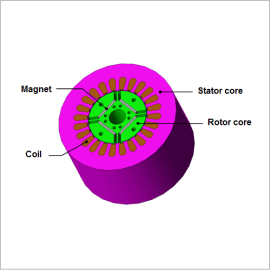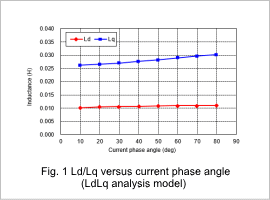Overview

This Application Note presents an analysis that obtains d/q-axis inductance in an IPM motor while assuming actual measurements in a stationary rotor.
Ld/Lq versus current phase angle /Inductance
From fig. 1, it is apparent that the d-axis inductance hardly changes depending on the current phase angle. The reason for this is that the inductance is small because the d-axis magnetic flux passes through a magnet with low permeability, meaning that it is not very affected by the magnetic saturation of the iron core because the magnet’s magnetic resistance makes a big contribution. On the other hand, the magnetic flux from the q-axis passes through the iron core, so the permeability is large compared with the d-axis, meaning that the inductance is large as well. The current phase also progresses, so when the magnetic flux is weaker the iron core’s magnetic saturation is alleviated, meaning that the q-axis inductance increases.
However, a three-phase current is not run with the method of calculation using the line-to-line inductance, so it is not possible to obtain the variations in d-axis/q-axis inductance caused by the current phase angle. The magnetic saturation conditions of the iron core are also different when running a three-phase AC and a line-to-line current, so the q-axis inductance has been generally overestimated. In contrast, the contribution of the aforementioned magnet’s magnetic resistance to the d-axis inductance is large, so there is not a big gap between the results of the two methods.




